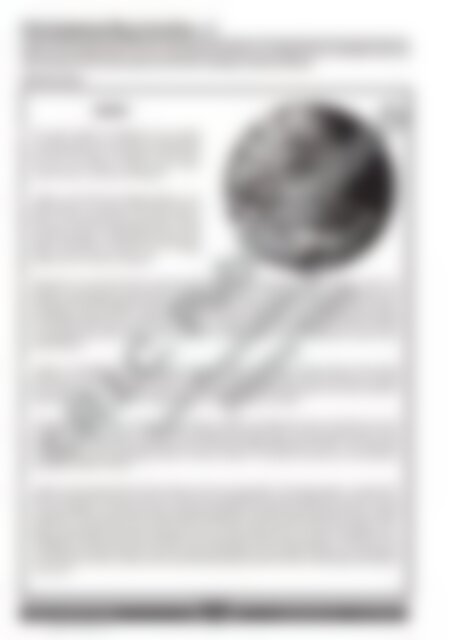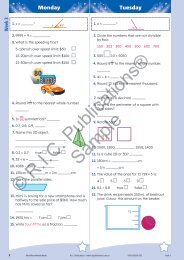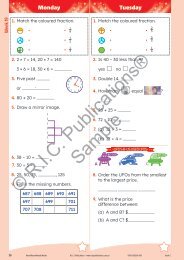RIC-5126 NZ Teaching Comp Strategies Book F
Create successful ePaper yourself
Turn your PDF publications into a flip-book with our unique Google optimized e-Paper software.
Understanding words – 1<br />
Words are the building blocks we use to communicate with others. It is important that we understand what they<br />
mean and that we know some ways to work out their meanings in different sentences.<br />
Read the report.<br />
Jupiter<br />
1.<br />
Our solar system is believed to be around<br />
4.5 billion years old. It consists of eight planets<br />
which orbit the Sun. The planets, in order from<br />
the Sun, are Mercury, Venus, Earth, Mars,<br />
Jupiter, Saturn, Uranus and Neptune.<br />
2.<br />
Jupiter is the fifth and largest planet in our<br />
solar system. Its volume is 1321 times that of<br />
Earth. It was named after the Roman king of<br />
the gods, which is appropriate since it is the<br />
king of the planets—a gas giant! Its diameter is<br />
about 143 000 km—that is over 11 times<br />
greater than the Earth’s diameter!<br />
3.<br />
Because it is so far from the Sun, approximately 750 000 000 kilometres, Jupiter is also very cold. The<br />
planet is surrounded by three layers of clouds, each made of different substances! Scientists were<br />
surprised to find that lightning occurs within these clouds, much the same as lightning occurs during a<br />
thunderstorm here on Earth. Jupiter is famous for the ‘Great Red Spot’, a storm that has been raging<br />
for more than 350 years. It can be seen just below Jupiter’s equator and looks rather small on the face<br />
of the planet. But, just remember how big Jupiter is; the Red Spot is actually equivalent in size to three<br />
planet Earths!<br />
4.<br />
Jupiter is a beautiful planet. Photographs taken on unmanned space missions leave most people<br />
awestruck. It has very distinctive bands of colour. It is believed that these coloured bands are caused<br />
by a combination of very strong winds travelling at several hundred kilometres per hour and by Jupiter’s<br />
high rotational speed. It takes 10 Earth hours for one full rotation of Jupiter.<br />
5.<br />
This amazing planet does not have a solid surface. Instead, it is believed to have a small rocky core at<br />
its centre, larger than Earth, surrounded by hydrogen and helium gas. It has also been found to have<br />
very thin rings. These cannot be seen by even the most powerful telescope on Earth. The rings were<br />
only discovered from photographs taken on space missions. The rings are made up of dust particles<br />
caused by Jupiter’s moons.<br />
6.<br />
Jupiter is surrounded by the most number of moons of any planet in the solar system—a total of 63.<br />
Some of these are unnamed, but four of them are considered to be quite significant! The first of these<br />
moons is called Io. Io has many active volcanoes and lakes of molten lava can be clearly seen on space<br />
expeditions. The second moon is Europa and it is believed to have an ocean under its icy surface, which<br />
leads to speculation that there may be some form of life present there. The third and largest moon,<br />
Ganymede, is larger than Pluto and Mercury and has large, smooth craters present. The fourth moon<br />
is Callisto and is also believed to have an ocean underneath its cold surface. Because of its large size<br />
and numerous moons, Jupiter and its surrounding bodies almost look like a small scale solar system<br />
on its own.<br />
<strong>Teaching</strong> comprehension strategies 4 www.ricpublications.co.nz ~ R.I.C. Publications ®<br />
ISBN 978-1-925431-24-7


















